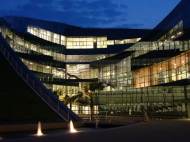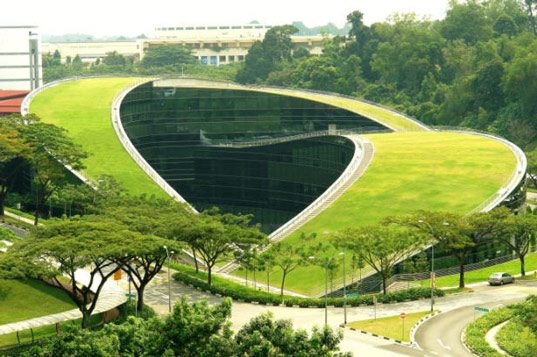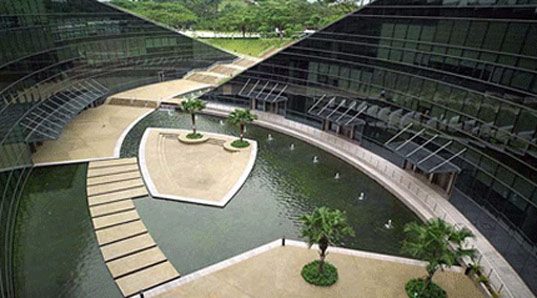Green architecture – Singapore art school
 We started our series of green architecture in one of our previous articles regarding the cacti resembling building in Qatar. This article is about the idea which takes over most of the modern architects, and that is placing green surfaces at the roofs of the buildings. This article is about the amazing green roof at the School of Art, Design and Media at Nanyang Technological University in Singapore. This 5 story facility sweeps a wooded corner of the campus with an organic, vegetated form that blends landscape and structure, nature and high-tech.
We started our series of green architecture in one of our previous articles regarding the cacti resembling building in Qatar. This article is about the idea which takes over most of the modern architects, and that is placing green surfaces at the roofs of the buildings. This article is about the amazing green roof at the School of Art, Design and Media at Nanyang Technological University in Singapore. This 5 story facility sweeps a wooded corner of the campus with an organic, vegetated form that blends landscape and structure, nature and high-tech.
The site is a wooded valley which was supposed to be left as a green lung in the master plan of the 200-hectare Nanyang Technological University campus. The designer-planners, however, carved a habitat from the constraints of the valley. Instead of imposing a building onto the landscape, they let the landscape play a critical role in the definition of the buildings shape. It allows the original greenery of the site to grow on the building.
The glass facade provides a high performance building envelope that reduces solar gain and heat load while allowing the benefits of natural views and daylight into creative spaces. The glass walls provide a visual exchange between indoors and the surrounding landscape or interior plaza as fluid spaces. The diffused natural daylight is abundant throughout studios and classrooms, thus making them productive spaces for young creators.
The curving green roofs distinguish the building from among the other structures on campus but the line between landscape and building is blurred. The roofs serve as informal gathering spaces. Besides that purpose, the roofs serve as open space, insulate the building, cool the surrounding air and harvest rainwater for the landscape irrigation.
This amazing design is surely going to be used more widely because it provides better and healthier surrounding. In this particular example it offers a brand new experience in many perspectives, fulfilling the intent that a school for art should inspire creativity, while solving the green surface deficiency.











It is laudable to see the efforts being made to reduce carbon emissions and to produce green and sustainable buildings. However, it is not enough. It is not nearly enough. More buildings, green, sustainable or otherwise are still just that-more buildings. It is so fundamentally simple. More buildings produce more destinations. More destinations produce more traffic. More traffic produces more congestion. More congestion is destroying us. Look at any major thorougfare in any city in the US and in many cities in the rest of the world at rush hour. That thoroughfare is almost certainly clogged to the point of gridlock with traffic, and it’s getting worse. Further, the ratio of vehicles, carrying just one passenger to all the rest of the vehicles, carrying two or more passengers is likely over 100:1. It’s ludicrous.
If we keep this up we will welt up like some overgrown bacteria colony that has chewed up its food supply and collapse back into ourselves in disease and death. We need to stop putting up more buildings unless it is absolutely necessary.
An increasing portion of the work product, produced today, can be sent over a wire, or wireless. In a growing number of cases it is no longer necessary to go to work. Work is not a place that you must go. It is something that you do.
Architects, who pat themselves on their collective backs, for being leaders in creative thought and action, almost overwhelmingly are continuing to reject this notion about work. They could but they have not yet become role models for what really needs to be done.
They need to give their staff laptops, send them home to work, shut their offices and throw away the keys. Doing this would be by way of example a demonstration of virtual architecture, which is the ultimate in “green” and sustainability. Additionally, whether these architects might realize it or not, the productivity and the profitability of their practices would go up significantly.
And if architects can accomplish this for themselve, then they can begin showing others how to do it, too. With or without architects it is starting to happen anyway. Virtual architectural environments are starting to crop up all over the place. Witness amazon.dom, dell.com, ebay. com, secondlife.com, and the staggering numbers of social media networking sites.
Architects must lead, follow or get the heck out of the way.
Best regards and good keyboarding to you,
Charles Traylor, AIA, NCARB
President
Archline-BIM-CAD Services for the Building Industry
15950 Dallas Parkway, Suite 400
Dallas, Texas 75248
Toll Free Number: (866) 412-5329
P.S. The Parkway address is window dressing. All Archline has at that Class A office building is a mailbox. We are a company, which typifies virtual architecture. We are an international wide area network of CAD collaborators, who come together on the Internet to produce BIM-CAD work product online. My work station is in a bedroom in my home. We have present and past collaborators all over the world. We have done work for over 150 architectural firms and over 1,000 of their projects in 26 states, The US Virgin Islands and overseas. Most of our collaborators and many of our architect-clients have never met anyone else in our network even once.
author
Well, I partially agree.
Not everyone is fit to fulfill the requirements for their studies or their work in order to finish their obligations from home. Architects on the other hand could work from home even in the past, when they drew the plans on the paper.
Some countries (especially USA where people travel from state to state in order to go to work) need to restructure their whole system of living and working.
The solution is not in entrapment of people within their living quarters in order to lessen the pollution. Smaller self sustainable communities would solve a lot of problems regarding carbon emission.